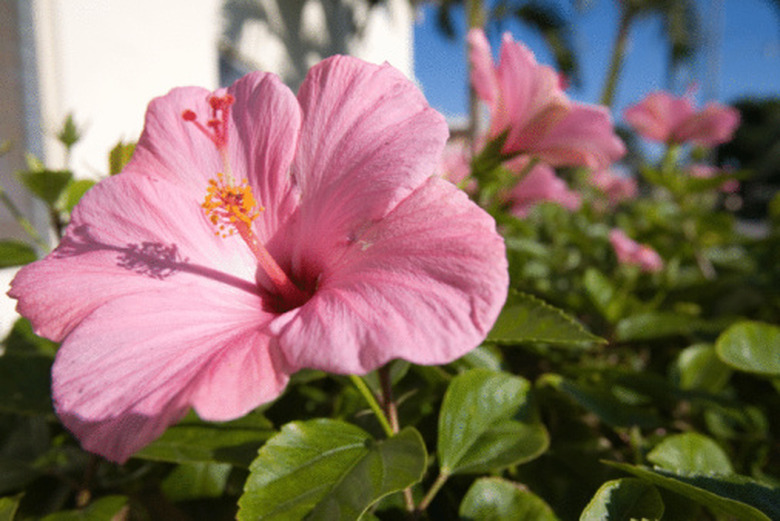How To Kill Aphids On A Hibiscus Tree Naturally
We may receive a commission on purchases made from links.
Hibiscus shrubs and trees (Hibiscus spp.) make for a showy addition to gardens and landscapes across their range. Their blossoms are beautiful and prolific (and widely used in herbal teas), and their foliage provides a visually useful backdrop for smaller annuals and perennials, as well as their own big blossoms. Hibiscus is not especially troubled by pests, making it a low-care option, but aphids can potentially infest your hibiscus. While pesticides will fix that, there are a number of natural-control measures you should try first.
Aphids on Hibiscus
Aphids on Hibiscus
Before you jump in with both feet, take a moment to ensure that it is in fact aphids you're dealing with: White insects on hibiscus are usually mealybugs; black bugs on hibiscus are typically hibiscus sawfly; aphids (mostly) show up in shades of green and brown that help them hide among foliage. Color is a less reliable indicator than their appearance (small, plump, slow-moving, communal) and the signs of their handiwork. These include leaves beginning to curl and glossy patches of their sugary excretions, called "honeydew," appearing on the plants' leaves. You may also see ants "herding" aphids like tiny farmers, though this isn't universal.
It's important to recognize that aphids aren't an immediate, existential threat to your hibiscus. Yes, they'll weaken your plants marginally, and they can spread disease, and mold spores might flourish in the honeydew they leave behind, but overall they're not a major threat (although aphids are more of a concern if you grow herbaceous perennial hibiscus, rather than the woody kind). Until and unless you see signs of a major infestation, aphids are something to monitor rather than reflexively eradicate.
With that in mind, there are several aphid-control strategies you can try before breaking down and reaching for a commercial pesticide. These techniques can be used individually or in combination, or as part of an overall integrated pest management strategy along with cultural controls (i.e., planting species that attract beneficial predators and avoiding over-fertilization). If you're even moderately diligent, you should have little trouble controlling your aphids without chemical pesticides.
Letting Nature Do the Work
Letting Nature Do the Work
Aphids are relatively immobile, have no natural defenses to speak of, and they're packed with sugary fluids. In other words, they're the candy bars of the natural world and a host of natural predators feed on them, including ladybug beetles, lacewing larvae, and a variety of parasitic wasps.
Check the website of your local extension service to find out which ones are common in your area, learn what they look like (in adult and larval forms), and then go look for them in your garden. If you see lots of them, or the withered remains of lots of dead aphids, relax. Predators have things under control, and you don't need to intervene.
If you like the idea of a natural control, but you're worried that your aphid population is growing faster than predators can eat them, you can simply buy additional predators. Common choices, such as ladybugs and lacewings, are widely available online and need only to be released in your garden where they'll cheerfully treat the aphids as an all-you-can-eat buffet.
Washing Them Off
Washing Them Off
Another low-impact method of aphid removal is simply washing them off. If you have a single, relatively small hibiscus, you could just use a cloth and a bucket of water, but that's time-consuming. It's easier to blast them off with your garden hose, making sure to hit the undersides of all the leaves (that's where aphids like to hide) as well as the stems. Repeat as needed to keep your aphid population under control.
Targeting the Ants
Targeting the Ants
If there's a tell-tale parade of ants to and from your afflicted hibiscus, targeting them — instead of going after the aphids directly — might be your best bet. There are many ways to do this: one is by encircling the trunk of your hibiscus tree with a sticky trap, preventing the ants from climbing up; another is to choose a suitable bait trap and place it between the ant nest and your tree. Without the ants' involvement, aphids will be more vulnerable to predation.
Introducing a Biological Control
Introducing a Biological Control
If these relatively low-impact solutions don't cure your problem, then calling on a targeted biological control is the next logical step. A fungus called Beauveria bassiana is a lethal parasite of soft-bodied insects like aphids, and it's very easy to use. It's available in powdered or liquid forms and simply needs to be mixed up and sprayed on your hibiscus every week or two. That makes it as low-effort as a chemical pesticide, but without the toxicity and broad impact on beneficial species.
References
- Texas A&M AgriLife Extension: Mealybugs on Hibiscus Common This Summer
- NC State Extension: Hibiscus Sawfly
- University of Florida IFAS Extension: Aaaahhhh – Aphids!
- University of California Integrated Pest Management Program: Ant Management in Gardens and Landscapes
- Clemson Cooperative Extension Home & Garden Information Center: Integrated Pest Management (IPM) for Aphids
